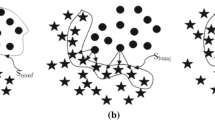Abstract
The real-time operator’s mental workload (MWL) monitoring system is crucial for the design and development of adaptive operator-aiding/assistance systems. Although the data-driven approach has shown promising performance for MWL recognition, its major challenge lies in the difficulty in acquiring extensive labeled data. This paper attempts to apply the semi-supervised extreme learning machine (ELM) to the challenging problem of operator’s mental workload classification based only on a small number of labeled physiological data. The real data analysis results show that the semi-supervised ELM method can effectively improve the accuracy and computational efficiency of the MWL pattern classification.
Access this chapter
Tax calculation will be finalised at checkout
Purchases are for personal use only
Similar content being viewed by others
References
Lal, S.K., Craig, A.: A critical review of the psychophysiology of driver fatigue. Biol. Psychol. 55(3), 173–194 (2001)
Bobko, N., Karpenko, A., Gerasimov, A., Chernyuk, V.: The mental performance of shiftworkers in nuclear and heat power plants of Ukraine. Int. J. Ind. Ergon. 21(3–4), 333–340 (1998)
Hollender, N., Hofmann, C., Deneke, M., Schmitz, B.: Integrating cognitive load theory and concepts of human–computer interaction. Comput. Hum. Behav. 26(6), 1278–1288 (2010)
Cain, B.: A review of the mental workload literature. Defence Research and Development Toronto (Canada) (2007)
Mahfouf, M., Zhang, J., Linkens, D.A., Nassef, A., Nickel, P., Hockey, G.R.J., Roberts, A.C.: Adaptive fuzzy approaches to modelling operator functional states in a human-machine process control system. In: Fuzzy Systems Conference, FUZZ-IEEE 2007, pp. 1–6. IEEE International, July 2007
Huang, G.B., Zhu, Q.Y., Siew, C.K.: Extreme learning machine: theory and applications. Neurocomputing 70(1), 489–501 (2006)
Huang, G.B., Zhou, H., Ding, X., Zhang, R.: Extreme learning machine for regression and multiclass classification. IEEE Trans. Syst. Man Cybern. Part B (Cybern.) 42(2), 513–529 (2012)
Liu, T., Yang, Y., Huang, G.B., Yeo, Y.K., Lin, Z.: Driver distraction detection using semi-supervised machine learning. IEEE Trans. Intell. Transp. Syst. 17(4), 1108–1120 (2016)
Wang, Y., Zhang, J., Wang, R.: Mental workload recognition by combining wavelet packet transform and kernel spectral regression techniques. IFAC-PapersOnLine 49(19), 561–566 (2016)
Okamoto, M., Dan, H., Sakamoto, K., Takeo, K., Shimizu, K., Kohno, S., Oda, I., Isobe, S., Suzuki, T., Kohyama, K., Dan, I.: Three-dimensional probabilistic anatomical cranio-cerebral correlation via the international 10–20 system oriented for transcranial functional brain mapping. Neuroimage 21(1), 99–111 (2004)
Zhang, J., Yin, Z., Wang, R.: Recognition of mental workload levels under complex human–machine collaboration by using physiological features and adaptive support vector machines. IEEE Trans. Hum.-Mach. Syst. 45(2), 200–214 (2015)
Sharma, P., Ray, K.C.: Efficient methodology for electrocardiogram beat classification. IET Sig. Process. 10(7), 825–832 (2016)
Wang, R., Wang, Y., Luo, C.: EEG-based real-time drowsiness detection using Hilbert-Huang transform. In: 7th International Conference on Intelligent Human-Machine Systems and Cybernetics (IHMSC), vol. 1, pp. 195–198. IEEE, August 2015
Huang, G., Song, S., Gupta, J.N.D., et al.: Semi-supervised and unsupervised extreme learning machines. IEEE Trans. Cybern. 44(12), 2405–2417 (2012)
Author information
Authors and Affiliations
Corresponding author
Editor information
Editors and Affiliations
Rights and permissions
Copyright information
© 2017 Springer International Publishing AG
About this paper
Cite this paper
Li, J., Zhang, J. (2017). Mental Workload Classification Based on Semi-Supervised Extreme Learning Machine. In: Lintas, A., Rovetta, S., Verschure, P., Villa, A. (eds) Artificial Neural Networks and Machine Learning – ICANN 2017. ICANN 2017. Lecture Notes in Computer Science(), vol 10614. Springer, Cham. https://doi.org/10.1007/978-3-319-68612-7_34
Download citation
DOI: https://doi.org/10.1007/978-3-319-68612-7_34
Published:
Publisher Name: Springer, Cham
Print ISBN: 978-3-319-68611-0
Online ISBN: 978-3-319-68612-7
eBook Packages: Computer ScienceComputer Science (R0)




